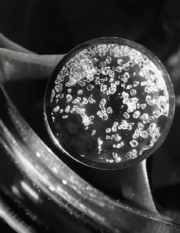Portal:Chemistry/Featured article/24
Xenon (/ˈzɛnɒn/ in the UK, /ˈziːnɒn/ in the US) is a chemical element that has the symbol Xe and atomic number 54. A colourless, dense, odourless noble gas, xenon occurs in the earth's atmosphere in trace amounts. Although generally unreactive, xenon can undergo a few chemical reactions such as the formation of xenon hexafluoroplatinate, the first noble gas compound to be synthesised.
Naturally occurring xenon is made of nine stable isotopes, but there are also over 40 unstable isotopes that undergo radioactive decay. The isotope ratios of xenon are an important tool for studying the early history of the Solar System. Xenon-135 is produced as a result of nuclear fission and acts as a neutron absorber in nuclear reactors.
Xenon is used in flash lamps and arc lamps, and as a general anesthetic. The first excimer laser design used a xenon dimer molecule (Xe2) as its lasing medium, and the earliest laser designs used xenon flash lamps as pumps. Xenon is also being used to search for hypothetical weakly interactive massive particles and as the propellant for ion thrusters in spacecraft.

